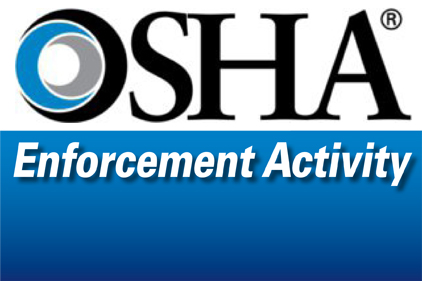 Rust-Oleum Corp., doing business as Synta Inc., was cited by OSHA for 33 serious safety and health violations for exposing full-time and temporary workers to crystalline silica dust, amputation and electrical hazards. OSHA initiated its inspection in February 2014, following a complaint alleging improper storage of material and inadequate forklift training. The proposed penalties total $188,500.
Rust-Oleum Corp., doing business as Synta Inc., was cited by OSHA for 33 serious safety and health violations for exposing full-time and temporary workers to crystalline silica dust, amputation and electrical hazards. OSHA initiated its inspection in February 2014, following a complaint alleging improper storage of material and inadequate forklift training. The proposed penalties total $188,500.
A carcinogen
Inhalation of respirable crystalline silica particles can cause silicosis, a disabling, nonreversible and sometimes fatal lung disease. Leading scientific organizations, including the American Cancer Society, have confirmed the causal relationship between silica and lung cancer.
"By failing to correct the violations identified, Rust-Oleum chose to ignore worker safety and exposed employees to hazards that could result in illness, injury or death," said Bill Fulcher, director of OSHA's Atlanta-East Area Office.
One repeat violation was cited for allowing employees to perform maintenance and servicing of equipment without ensuring the machine could not restart. The company was cited for this same violation in January 2011 at a workplace in Pleasant Prairie, Wisconsin.
OSHA cited the employer for 26 serious violations for exposing an employee to crystalline silica at levels of more than two times the exposure limit; failing to develop procedures to protect workers from moving machine parts during servicing and maintenance; exposing workers to crushing and struck-by hazards by not replacing or repairing damaged storage rack shelving; and allowing electrical equipment to be installed or used without following manufacturer instructions. The employer failed to administer and implement an occupational noise monitoring program; to provide adequate protective equipment, such as a chemical apron for employees working with corrosive materials; and did not develop or implement a written hazard communication program for employees working with hazardous chemicals. To view the citations, including six other violations, visit
http://www.osha.gov/ooc/citations/Rust-OleumCorporationdbaSynta_959625_0804_14.pdf*
http://www.osha.gov/ooc/citations/Rust-OleumCorporationdbaSynta_958068_0804_14.pdf*
Recent history of citations
Rust-Oleum Corp. has been in business since 1921 and acquired the Clarkston facility, formerly Synta Inc., in September 2012. Synta was established in 1993 and is a paint and coating manufacturer that sells its products through home improvement, hardware and other retail stores. Synta employs approximately 1,500 workers. The company's corporate headquarters is in Vernon Hills, Illinois.
OSHA has conducted six previous inspections at Synta in the last five years. Most recently, in April 2012, Synta was cited for failure to have machine guarding and an eyewash station and lack of a hazard communication plan.
At the time of the inspection, two staffing agencies were on-site, Impact Staffing Corp. and Precision Employment Group. The staffing agencies did not maintain supervision at the company and were not knowledgeable about hazardous conditions at the facility. No citations were proposed for the staffing agencies.
In April 2013, OSHA announced an initiative to improve workplace safety and health for temporary workers.
New PELs proposed for silica
OSHA has recently proposed to update its current silica standard. Published in the Federal Register on Sept. 12, 2013, OSHA's Notice of Proposed Rulemaking on Occupational Exposure to Crystalline Silica aims to update the inconsistent and outdated permissible exposure limits for crystalline silica in general industry, construction and shipyards, and establish other provisions to protect workers better. OSHA just concluded three weeks of hearings on the proposed rule and is now receiving post-hearing comments. Additional information on the proposed rule, including five fact sheets, is available at http://www.osha.gov/silica/.


